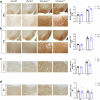Systemic inflammation accelerates neurodegeneration in a rat model of Parkinson's disease overexpressing human alpha synuclein
- PMID: 39500895
- PMCID: PMC11538257
- DOI: 10.1038/s41531-024-00824-w
Systemic inflammation accelerates neurodegeneration in a rat model of Parkinson's disease overexpressing human alpha synuclein
Abstract
Increasing efforts have been made to elucidate how genetic and environmental factors interact in Parkinson's disease (PD). In the present study, we assessed the development of symptoms on a genetic PD rat model that overexpresses human α-synuclein (Snca+/+) at a presymptomatic age, exposed to a pro-inflammatory insult by intraperitoneal injection of lipopolysaccharide (LPS), using immunohistology, high-dimensional flow cytometry, constant potential amperometry, and behavioral analyses. A single injection of LPS into WT and Snca+/+ rats triggered long-lasting increase in the activation of pro-inflammatory microglial markers, monocytes, and T lymphocytes. However, only LPS Snca+/+ rats showed dopaminergic neuronal loss in the substantia nigra pars compacta (SNpc), associated with a reduction in the release of evoked dopamine in the striatum. No significant changes were observed in the behavioral domain. We propose our double-hit animal as a reliable model to investigate the mechanisms whereby α-synuclein and inflammation interact to promote neurodegeneration in PD.
© 2024. The Author(s).
Conflict of interest statement
The authors declare no competing interests.
Figures






References
-
- Hoehn, M. M. Parkinsonism: onset, progression, and mortality. - PubMed
-
- Jellinger, K. A. Neuropathobiology of non-motor symptoms in Parkinson disease. J. Neural Transm.122, 1429–1440 (2015). - PubMed
-
- Bernheimer, H., Birkmayer, W., Hornykiewicz, O., Jellinger, K. & Seitelberger, F. Brain dopamine and the syndromes of Parkinson and Huntington Clinical, morphological and neurochemical correlations. J. Neurol. Sci.20, 415–455 (1973). - PubMed
-
- Spillantini, M. G. et al. α-Synuclein in Lewy bodies. Nature388, 839–840 (1997). - PubMed
LinkOut - more resources
Full Text Sources
Miscellaneous

